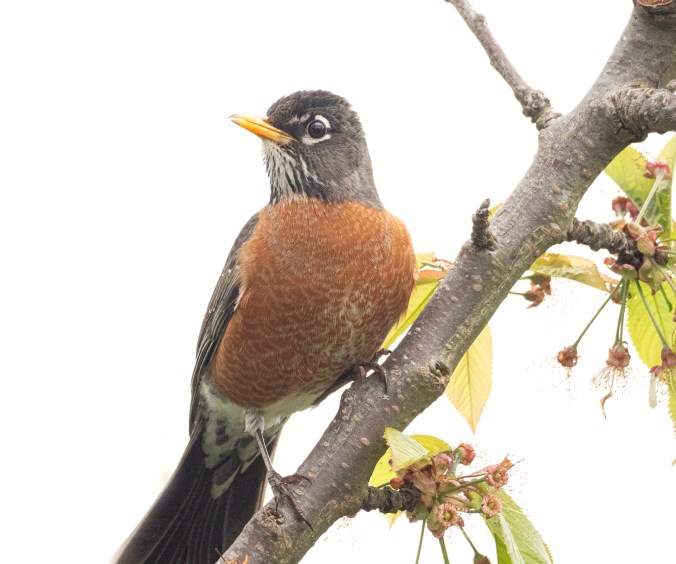
It seems that nostalgic European settlers have long been prone to naming any bird with a flash of red on the chest “robins” after the beloved little birds they remember from home.
The European, and seemingly original, robin is a small bird — part of the flycatcher family, with a red orange breast and face. The North American robin is an entirely different bird. Part of the thrush family, it’s much bigger, with a yellow beak and striking white markings around the eyes. Really the only point of commonality is that red breast.
Further afield, in Australia you can find the Flame Robin, Scarlet Robin, Red-Capped Robin — none of which are related to either the European or American varieties, except in that little flash of red breast. More homesick settlers, I’m thinking.
I grew up in the UK, so I have tended to think of the British robin as the “real” one.
In reality, the only birds I was actually familiar with as a child growing up on the industrial docks of the Tyne, were gulls and pigeons. Lots and lots of pigeons!
But robins did loom large in my imagination. Each Christmas my mum decorated the snow-peaked ( and rock hard) royal icing on the Christmas cake with with a small flock of plastic robins, to accompany the rather frightening plaster Santa with mis-matched eyes.
Somehow, I still have a single one of these little robins, although most of his red breast paint has now worn off.
Robins were, and still are, as far as I know, featured on cards and stamps to celebrate the Festive Season in Britain. In the Victorian era, when the sending and receiving of festive greeting cards first became fashionable, the mail carriers wore red tunics and were nicknamed robin redbreasts — bringers of winter cheer, just like the birds.
The British robins stay put all year round, but are less obvious in the summer months — probably being busy with nesting and all, and are more associated with chirpy, charming and colourful company through the winter months.
Whenever I go back to Britain I’m constantly on the lookout for a robin. For some reason, the only place I ever see them close up is at the tea rooms of Portmeirion village in North Wales.
I like to imagine they’re all there, just waiting for me, one robin generation after another.
British robins are very, very territorial, so that’s just about possible. They are so very fierce about defending their home turf that 10% of mature male birds actually die doing just that.

Having been in Canada now for most of my life, my Robin Reality has now switched to the North American variety, which has its own charm.
Seasonally, the robins here are most associated with spring, when they’re the first birds to sing in the morning, and the last to fall quiet at night.
Although we think of them in connection with spring, when their courting song fills the air, they’re actually around all winter here in Vancouver. Perhaps we don’t notice them so much because they behave very differently during the colder months.
In spring they form pairs and are territorial like their European namesakes, but in winter they live rather cooperatively in large nomadic flocks, sometimes with starlings and other birds, like Cedar Waxwings. They pop up in large groups whenever they find a good source of fruit on trees. Holly, juniper, crabapples and hawthorn are all robin-approved winter fare.
Fun fact: American robins have an extendible esophagus, which allows them to store berries harvested in the daytime for an evening snack to help survive the cold nights.
(I am reminded of the rather terrifying Horlicks TV ads of my youth, where a scientific looking graph traced the worrying arc of “night starvation” — a fate that could only be avoided by imbibing a nice cup of pre-bed Horlicks. I expect night starvation is much more of a reality for a wild robin than for a well fed child of the 1960’s.)
Once spring arrives, the flocks disperse and robins break into pairs, staking out and aggressively defending nesting territory.
When the berries are finished they’ll happily switch to yanking worms out of lawns.
One of my favourite things about the spring and summer robin, apart from the singing, is the gusto with which they take a bath. If the birdbath is suddenly empty, I assume that an enthusiastic robin has just used the facilities.
The folklore around how robins of all types first acquired that fiery red breast is strikingly similar on both sides of the Atlantic. In all versions of the tale, the brave little robin saves sleeping humans from freezing, using their wings to fan the embers of a dying fire, in spite of the heat and danger. As a reward for their heroism, the robin is awarded the red breast as a badge of honour.
Here’s a beautifully illustrated version of the Sechelt People’s version of the story by Charlie Craigan.
It’s nice to know that however far you travel, they’ll always be some sort of robin to fall in love with.
Echoes of If You Can’t Be with the One You Love, Honey, Love the One You’re With.
For more posts on the joy of watching robins, and other birds, bathing:
- Joe de Vivre
- How to Keep Your Cool
- Novice Hummingbird
- Hummingbird Interlude
- Beat the Heat, Bird-Style
__________________________________________________________________________________________
© junehunterimages, 2021. Unauthorized use and/or duplication of this material without express and written permission from this blog’s author and/or owner is strictly prohibited. Excerpts and links may be used, provided that full and clear credit is given to junehunterimages with appropriate and specific direction to the original content.
















